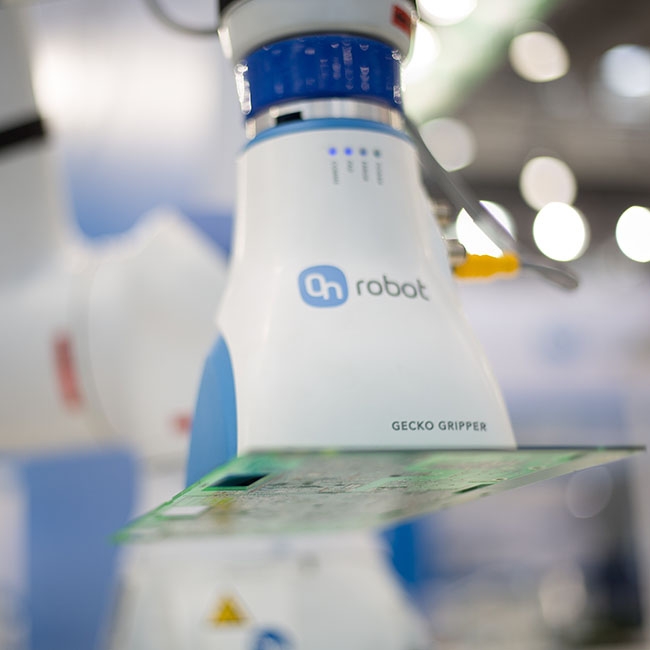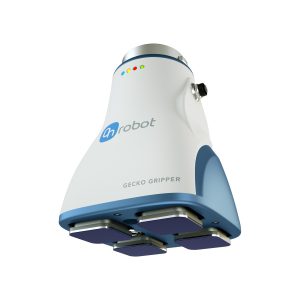Industrial vs. collaborative robots: end-of arm tooling makes ...
If you’re looking into collaborative automation, EoAT is the key in optimizing your processes and growing your business with greater flexibility, higher output and ...

The grippers know the correct angle, precision and force to apply while handling an object before the task even begins.
Humans are more connected than ever before, and that’s true of industrial automation as well. This age of unparalleled connectivity spurs expectations for faster and more scalable production, but for businesses it’s no longer just about automation itself. Instead, the focus has shifted to collaborative automation, wherein multiple tasks of differing magnitude and difficulty can be automated to achieve greater productivity and cost effectiveness than was previously possible.
Collaborative applications typically involve humans, robots, robot accessories and objects interacting with each other on varying levels to automate various tasks. These characteristics make collaborative applications easily deployable, reducing costs. The objects, of course, are a particularly important component in this work flow, which means that modern industrial automation must be able to accurately sense, identify and manipulate them.

End effectors, or end-of-arm tooling (EOAT), are the physical interface between the robot and collaborative application. Since these applications demand that objects be handled in extremely flexible and autonomous ways, poorly selected EOAT incapable of meeting those demands can severely limit an application’s collaborative potential, which leads to process delays and harm to the production line.
Modern grippers, however, are up to the challenge. They are designed with state-of-the-art gripping techniques and able to have each step of a gripping task programmed well in advance. Importantly, this means the grippers know the correct angle, precision and force to apply while handling an object before the task even begins.
For instance, force-based gripping technique, which is useful in such applications as packaging and palletising, machine tending and assembly, enables flexible production with minimal downtime. In-built force/torque sensors have integrated force control software and proximity sensors with optical technology that helps grippers detect an object’s location, even when it is not precisely positioned. This technology is well-suited to collaborative applications since the gripper can “see” and “feel” the objects using its built-in force/torque sensing.
Another breakthrough technology, called ‘Gecko,’ utilizes special adhesives to pick and place flat and smooth objects, as well as porous objects. This is a special adhesive technology invented by OnRobot which does not require vacuum or an external air supply. This technology is especially beneficial in the electronics industry with printed circuit boards (PCB). Holes in PCBs make them hard to grip using vacuum technology.
OnRobot grippers are designed to seamlessly integrate with collaborative applications and are built for easy “plug-and-produce” automation. These grippers can attach to any robot, and end users can control the gripper using the software panel’s embedded programming. This is advantageous for large businesses, as well as for small and midsize enterprises seeking agility and cost-efficiency as their low-volume, high-mix production needs change.
Computer Numerical Control (CNC) machines are expensive, ranging between €80,000 and €1million. Hence, manufacturers are constantly looking at ways to get the most out of these machines. A single gripper is often used in CNC machine tending tasks. This method means the machine is left idle for a long time, having huge cost implications for the business. Instead, manufacturers can use dual grippers to maximise production. OnRobot’s RG2 or RG6 dual grippers boosts machine utilization. While one gripper removes a processed part from the machine, the second picks the next raw part to be loaded into the machine, reducing cycle time, improving efficiency and increasing output.
The collaborative application determines the EOAT type, and in turn intelligent features in the EOAT arbitrate the automation quality.
For example, if a robot is tasked with picking up a plastic sheet, its grippers will be equipped with pneumatics or vacuum cups. For applications that need a two-finger gripper, the wise choice would be a gripper that is easy to install and program, and is cost-effective. And, if product mix changes are frequent, a gripper with an adjustable stroke and gripping force would be best.
Advanced EOATs should be able to satisfy these disparate needs and adhere to the end user’s long-term best interests. Average intelligence in robot accessories is no longer sufficient—to create the agile, hyper-connected and collaborative environments envisioned by Industry 4.0, these accessories must have elevated intellect.
The days of large, centralized production are over, and automated processes are too costly to be rebuilt for every modification and design change, especially for SMEs.
The new direction in industrial automation is about adding intelligence to end-effectors so that the robot can become smarter. Adopting advanced EOATs with intelligent sensors and inbuilt software will help producers to be more agile, connected and collaborative. They will also open doors to new automation possibilities for businesses. Today businesses need flexible, highly adaptive automation solutions. Therefore, intelligent tools that make automation more collaborative, cost-efficient, scalable and connected should be prioritized. This new curated range of advanced EOAT is finally helping deliver the promise of remote-controlled automation.
If you’re looking into collaborative automation, EoAT is the key in optimizing your processes and growing your business with greater flexibility, higher output and ...
The grippers know the correct angle, precision and force to apply while handling an object before the task even begins.
With end-of-arm tooling, automation becomes more inclusive, enabling collaborative applications to meet modern automation needs.
Collaborative applications allow workers and robots to operate safely side by side due to the user-friendly nature, intuitive programming and safety features of EOAT-fitted ...

special adhesive technology with no-mark gripping inspired by nature
5,385.00€
within 7 work days
for all EU orders
discount for next purchase